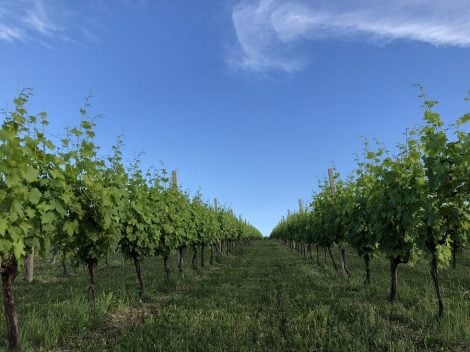Tintilia is an ancient black grape variety that risked disappearing before finding its rightful place and consideration in the rich Italian ampelographic landscape, thanks to some producers who in the 1990s decided to invest in the grape and the wine obtained from it. Tintilia, also produced in Reserve and Rosé versions, has been DOC since 2011.
The origins of viticulture in Molise are ancient, dating back to the Samnites, even before the Romans extended cultivation in a wider territory. Most likely, tintilia was introduced to Molise in the second half of the 18th century, during the Spanish domination of the Bourbons. Its name would also derive from the word tinto, which in Spanish means red. The grape found in Molise the ideal climatic conditions to spread, so much so that in the 19th century it was the most widespread grape, especially in the inland areas of the region. After the war, the search for more productive vines and the shift of cultivated areas towards flat areas led to a progressive abandonment of tintilia vineyards, until they almost completely disappeared. Only in the last few decades has interest been revived in this precious heritage of Molise's oenology, with the recovery of the grape and its vinification in purity.
Several times during tastings, we found ourselves facing a very appealing register delicately peppery, which has to do with its stylistic DNA beyond the use of wood, not always perfectly calibrated in the region. Even though we are far from the hyper-concentrated and toasted wines of some years ago.
Tintilia is a rustic grape variety that withstands cold well but is not very vigorous and has a rather low productivity. The grapes, with their black-blue color, have good aromaticity and give rise to a very particular wine, with an intense and full color. The olfactory profile is characterized by elegant spicy notes, which blend with hints of red fruit. It has a good structure, warm in the mouth, and expresses complex aromas. The finish has a nice persistence. Good acidity and important tannins recommend aging for medium to long periods, even in tonneaux, to give the wine greater softness and drinkability. A wine to rediscover and enhance at the table, paired with lamb, grilled meats, and hunter's style dishes.

The best Tintilia wines from Molise
Here are the best Tintilia wines according to Gambero Rosso, either in purity or present in high percentage in the indicated wines, which this year obtained the Due Bicchieri Rossi, having reached the final during the tastings for the Gambero Rosso 2024 Wine Guide, or the Due Bicchieri.
Once again, Tenimenti Grieco's Tintilia 200 Metri confirms itself as a wine of great pleasantness, and this year it received the award for the best quality-price ratio regionally in the 2024 Berebene guide from Gambero Rosso. Red flowers and spices, red cherry, raspberries, balsamic puffs, and Mediterranean scrub: it is the wide and multifaceted profile of a red wine that shines for its simplicity and fragrance, without being banal. From the ashes of the former Masseria Flocco, in 2013 Tenimenti Grieco was born, the creation of Antonio Grieco, a businessman from Puglia who decided to invest in neighboring Molise. The base is in Portocannone, with the Tremiti islands breaking the horizon towards the Adriatic and the Apennines behind. The vineyards extend over 85 hectares with a rather varied palette of grape varieties: montepulciano, falanghina, and tintilia alternate with international grapes, giving life to a range of wines united by fruity clarity and pleasantness.
Macchiarossa is a Tintilia that flaunts an intriguing profile of Mediterranean scrub, to which is added a beautiful sweet note of blackberry and a slightly spicy touch of black pepper. In the mouth, it is solid in the tannic texture, pleasant, and compact. The 66 is darker and deeper, displaying hints of graphite and tar, and blueberries. It is still the sensation of Mediterranean scrub that leads the way to a dense and material mouth, enlivened by a juicy saline trail. Claudio Cipressi began his journey in the world of wine when he learned about an almost extinct Molisan indigenous grape variety; it was tintilia. So, in 2000, he decided to leave his previous activity to start a winery with the aim of enhancing this grape. More than twenty years later, we can say that the goal has been achieved: the 15 hectares of vineyards, cultivated organically in the territory of San Felice del Molise, give life to a solid range that returns the identity of a winemaker who dedicates body and soul to his project.
- Molise Tintilia Macchiarossa 2018 - Claudio Cipressi
- Molise Tintilia 66 2017 - Claudio Cipressi
- Molise Tintilia Rosato Collequinto 2022 - Claudio Cipressi
Cherry and strawberry characterize San Zenone's 2020 Tintilia, juicy and with a finish played on chocolate tones. Raspberries and blueberries pass the baton in the aromatic profile of Molise Rosso Clivia '21, fruit sweet in the sip marked by tannin; joyful and carefree drink.
The 2020 Tintilia from Terresacre is one of the wines produced and presented this year by the company from Montenero di Bisaccia, founded in 2006. The wine is slightly blood-red, then coffee and chocolate take over.
Colle Cervino is a Tintilia that smells of dehydrated plums and black cherries. In the mouth, it has a good fruity attack that turns into a juicy and smooth sip. Interesting is the 2021 Tintilia in Amphora, which smells of red and black fruits. A hint of rusticity does not affect a fragrant and lively palate, veined with a pleasant salty undertone. A note of Mediterranean scrub characterizes the 2020 Tintilia S, with an inviting and fresh mouthfeel. The 2018 Reserve is very spicy, denser in tannic texture. Started in the 1990s, Vincenzo Catabbo's company is located on the hills of San Martino in Pensilis, a stone's throw from the Adriatic Coast. The vineyard extends over 40 hectares, with a good part, 13 hectares, dedicated to tintilia.
- Molise Tintilia Colle Cervino 2020 - Catabbo
- Molise Tintilia in Anfora 2021 - Catabbo
- Molise Tintilia S 2020 - Catabbo
- Molise Tintilia Vincè Ris. 2018 - Catabbo
G.S.N. is a 2020 Tintilia that smells of ripe red cherry, has a voluminous and warm mouthfeel, and good tannic extraction. Opalia 2020 recalls tar and graphite, is spicy, and boasts a dense and compact palate. In the province of Isernia, where Molise becomes wilder, we find the Valerio family's company: the vineyard consists of five different estates where mostly tintilia, montepulciano, sangiovese, and falanghina are cultivated.
Very pleasant is the 2022 Ros-is, a rosé from tintilia grapes, citrusy and fresh, vaguely herbaceous, tense and with good progression. Rutilia 2019 is a Tintilia that smells of strawberries and cherries, red roses, and medicinal herbs. In the mouth, it is slightly herbaceous and has very dense tannins. The plots enhanced by the Salvatore family with deep-rooted awareness are concentrated in the suggestive area of Ururi. Pasquale Salvatore manages an estate of about eighty hectares, where, in addition to the 20 vineyards, there are also arable lands and olive groves.


 US tariffs: here are the Italian wines most at risk, from Pinot Grigio to Chianti Classico
US tariffs: here are the Italian wines most at risk, from Pinot Grigio to Chianti Classico "With U.S. tariffs, buffalo mozzarella will cost almost double. We're ruined." The outburst of an Italian chef in Miami
"With U.S. tariffs, buffalo mozzarella will cost almost double. We're ruined." The outburst of an Italian chef in Miami "With US tariffs, extremely high risk for Italian wine: strike deals with buyers immediately to absorb extra costs." UIV’s proposal
"With US tariffs, extremely high risk for Italian wine: strike deals with buyers immediately to absorb extra costs." UIV’s proposal Meloni: "Tariffs? If necessary, there will be consequences. Heavy impact on agri-food sector"
Meloni: "Tariffs? If necessary, there will be consequences. Heavy impact on agri-food sector" The Government honours the greats of Italian cuisine, from Bottura to Pepe. Massari: "Thank you, Meloni, the only one who listened to us"
The Government honours the greats of Italian cuisine, from Bottura to Pepe. Massari: "Thank you, Meloni, the only one who listened to us"







